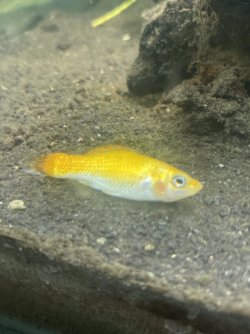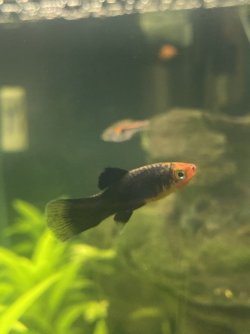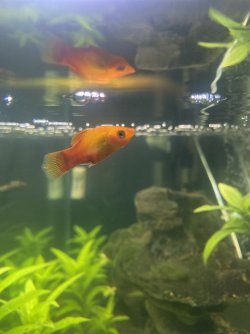Hello,
So I have a 130 litre tropical aquarium that has been running for at least 7 years now. For the past year I’ve only had black skirt tetras, black phantom tetras and rasboras, all of which are doing fine. About 6 weeks ago I purchased 4 Platys and 4 mollies and didn’t even think to quarantine them. Slowly one by one the Platys and mollies have been dying. One day it will be swimming around and eating normally, then over the next 3 days or so it will start spending more and more time lying on the bottom of the tank (though still coming up to eat, then slowly sinking back to the bottom) before dying, whilst the others swim and eat fine. To me they look fine physically so I’m stumped as to what is causing this.
I had my 4th death yesterday and it looks as though the 5th will die by tomorrow (it’s still swimming up to eat as of 10 minutes ago). I’ve just noticed that the one that is currently sickest seems to have a round mark/hole on it that wasn’t there yesterday..
After the first death I started dosing weekly with Aqua One Broad Spectrum Remedy for 4 weeks (which obviously hadn’t helped). The past 2 days I’ve been dosing with API Pimafix instead, however now the remaining mollies/platys are also starting to spend more time hiding/at the bottom of the tank. I’m at a total loss. Please help!
Tested water yesterday:
Ph 7.6
Ammonia 0
Nitrite 0
Nitrate 40-80(max)
So I have a 130 litre tropical aquarium that has been running for at least 7 years now. For the past year I’ve only had black skirt tetras, black phantom tetras and rasboras, all of which are doing fine. About 6 weeks ago I purchased 4 Platys and 4 mollies and didn’t even think to quarantine them. Slowly one by one the Platys and mollies have been dying. One day it will be swimming around and eating normally, then over the next 3 days or so it will start spending more and more time lying on the bottom of the tank (though still coming up to eat, then slowly sinking back to the bottom) before dying, whilst the others swim and eat fine. To me they look fine physically so I’m stumped as to what is causing this.
I had my 4th death yesterday and it looks as though the 5th will die by tomorrow (it’s still swimming up to eat as of 10 minutes ago). I’ve just noticed that the one that is currently sickest seems to have a round mark/hole on it that wasn’t there yesterday..
After the first death I started dosing weekly with Aqua One Broad Spectrum Remedy for 4 weeks (which obviously hadn’t helped). The past 2 days I’ve been dosing with API Pimafix instead, however now the remaining mollies/platys are also starting to spend more time hiding/at the bottom of the tank. I’m at a total loss. Please help!
Tested water yesterday:
Ph 7.6
Ammonia 0
Nitrite 0
Nitrate 40-80(max)





